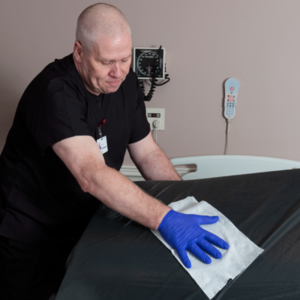Interventional Care


We notice that you are visiting us from . This site only services US-based visitors. Would you like to visit the site that is appropriate for your location?

Microbial assessment of healthcare-associated pathogens on various environmental sites in patient rooms after terminal room disinfection authored by Kanamori H, Rutala WA, H, Gergen MF, Sickbert-Bennett EE, Knelson LP, Anderson DJ, Sexton DJ, Weber DJ, and the CDC Prevention Epicenters Program.
Over the past decade, there is excellent evidence in the scientific literature that contaminated environmental surfaces and shared noncritical patient care items play an important role in the transmission of several key healthcare-associated pathogens including methicillin-resistant S. aureus (MRSA), VRE, Acinetobacter, norovirus, and C. difficile. All these pathogens have been demonstrated to persist in the environment for days (in some cases months), frequently contaminate the environmental surfaces in rooms of colonized or infected patients, transiently colonize the hands of healthcare personnel, be transmitted by healthcare personnel, and cause outbreaks in which environmental transmission was deemed to play a role.
Further, admission to a room in which the previous patient had been colonized or infected with MRSA, VRE, Acinetobacter, or C. difficile, has been shown to be a risk factor for the newly admitted patient to develop colonization or infection. Thus, surface disinfection of environmental surfaces and shared medical devices (defined as those that contact intact skin) is one of the important infection prevention strategies to prevent pathogen transmission. In this study, we investigated the microbial burden of aerobic bacteria and epidemiologically important pathogens (EIP) on high-touch hospital room environmental sites after standard or enhanced terminal room disinfection (Quat/UV-C, bleach, or bleach/UV-C) in a large clinical study.
An environmental assessment was performed following terminal room decontamination using Rodac plates to sample 8 of 10 hospital room sites (e.g., bed rail, over bed table, chair, toilet seat). The number of colony-forming units (CFUs) of aerobic bacteria and 4 target EIPs, including multidrug-resistant Acinetobacter (MDRA), methicillin-resistant S. aureus (MRSA), vancomycin-resistant enterococci (VRE), and Clostridioides difficile, was counted. A total of 3675 samples from 736 environmental sites in 92 patient rooms (21 standard and 71 enhanced rooms) at 3 study hospitals were analyzed.
Overall, the frequency of all environmental sites positive for EIP was 11.4% (84/736) in all rooms, 21.4% (36/168) in standard rooms, and 8.5% (48/568) in enhanced disinfection rooms. Environmental sites in standard rooms were more likely to be contaminated with EIPs than in enhanced disinfection rooms. The mean number of CFUs in EIPs per site was 2.4 in all rooms, 7.6 in standard rooms, and 0.9 in enhanced disinfection rooms.
Our microbial analysis from a large clinical disinfection study demonstrated that enhanced terminal room disinfection, including the use of a UV-C device, reduced the microbial burden of healthcare-associated pathogens, especially MDRA and VRE, on environmental sites better than standard room disinfection.
Disclosure: Dr. Rutala is a consultant for PDI.
Kanamori H, Rutala WA, Gergen MF, Sickbert-Bennett EE, Knelson LP, Anderson DJ, Sexton DJ, Weber DJ and the CDC Prevention Epicenters Program. Microbial assessment of health care-associated pathogens on various environmental sites in patient rooms after terminal room disinfection. Open Forum Infect Dis. 2021. doi: